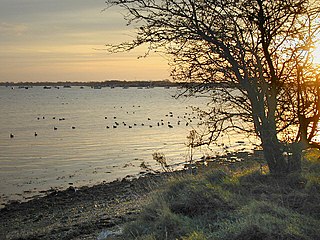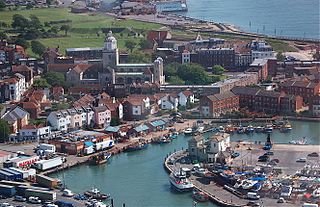
Hayling Island is an island off the south coast of England, in the borough of Havant in the county of Hampshire, east of Portsmouth.

Portsmouth is a port city and unitary authority in Hampshire, England. Most of Portsmouth is located on Portsea Island, off the south coast of England in the Solent. This means Portsmouth is the only English city not located primarily on the mainland. Located 74 miles (119 km) south-west of London, 50 miles (80 km) west of Brighton and Hove, and 22 miles (35 km) south-east of Southampton; Portsmouth is part of the South Hampshire conurbation. It is the most densely populated city in the United Kingdom, with a population last recorded at 208,100.

Southsea is a seaside resort and a geographic area of Portsmouth, Portsea Island in England. Southsea is located 1.8 miles (2.8 km) to the south of Portsmouth's inner city-centre.

Havant is a town in the south-east corner of Hampshire, England between Portsmouth and Chichester. Its borough comprises the town (45,826) and its suburbs including the resort of Hayling Island as well as Rowland's Castle, the larger town of Waterlooville and Langstone Harbour. Housing and population more than doubled in the 20 years following World War II, a period of major conversion of land from agriculture and woodland to housing across the region following the incendiary bombing of Portsmouth and the Blitz.

The fortifications of Portsmouth are extensive due to its strategic position on the English Channel and role as home to the Royal Navy. For this reason, Portsmouth was, by the 19th century, one of the most fortified cities in the world. The fortifications have evolved over the centuries in response to changes in tactics and technology and the area defended has increased. While the first defences focused on Portsmouth harbour, in step with the fortifications of Gosport, later defensive structures protected the whole of Portsea Island and an increasing distance inland. At the same time, the fortifications of Portsmouth and Gosport became part of the wider fortifications of the Solent. Old Portsmouth, on the southwest corner of Portsea Island, has been walled for much of its history.

Portsea Island is a flat and low-lying natural island 24.5 square kilometres in area, just off the southern coast of Hampshire in England. Portsea Island contains the majority of the city of Portsmouth.

Fort Cumberland is a pentagonal artillery fortification erected to guard the entrance to Langstone Harbour, east of the Dockyard of Portsmouth on the south coast of England. It was sited to protect the Royal Navy Dockyard, by preventing enemy forces from landing in Langstone Harbour and attacking from the landward side. Fort Cumberland is widely recognised as the finest example of a bastion trace fort in England. It is a scheduled monument and a Grade II* listed building
Sinah is the area at the southwestern end of Hayling Island. It incorporates the Ferrypoint, Sinah Beach, The Kench, Sinah Warren, and Sinah Common. It is bounded to the east by West Town. Langstone Harbour and its entrance form the north and west borders, and to the south is Hayling Bay.

Gunwharf Quays is a shopping centre located in the Portsea area of the city of Portsmouth in England. It was constructed in the early 21st century on the site of what had once been HM Gunwharf, Portsmouth. This was one of several such facilities which were established around Britain and the Empire by the Board of Ordnance, where cannons, ammunition and other armaments were stored, repaired and serviced ready for use on land or at sea. Later known as HMS Vernon, the military site closed in 1995, and opened to the public as Gunwharf Quays on 28 February 2001 after six years of reconstruction. The landmark Spinnaker Tower, which stands close to the site on pilings in Portsmouth Harbour, was opened on 18 October 2005.

Langstone Harbour is a 2,085.4-hectare (5,153-acre) biological Site of Special Scientific Interest in Hampshire. It is an inlet of the English Channel in Hampshire, sandwiched between Portsea Island to the south and west, Hayling Island to the south and east, and Langstone to the north. It is part of the Ramsar site of Langstone and Chichester Harbour Special Protection Area and Nature Conservation Review site. Parts are Special Areas of Conservation, or Local Nature Reserves, and some areas by the Hampshire and Isle of Wight Wildlife Trust.

Copnor is an area of Portsmouth, England, located on the eastern side of Portsea Island. The population of Copnor Ward at the 2011 Census was 13,608. As Copenore, it was one of the three villages listed as being on Portsea Island in the Domesday book.

Hilsea is a district of the city of Portsmouth in the English county of Hampshire. Hilsea is home to one of Portsmouth's main sports and leisure facilities – the Mountbatten centre. Trafalgar School is also in Hilsea. It is also the home of Portsmouth rugby football club
Milton is a residential area of the English city of Portsmouth, Hampshire, England, on the south eastern side of Portsea Island. Milton is bordered on the eastern coast of Portsea Island by Langstone Harbour, with Eastney to the south-east, Southsea to the south-west, Baffins to the north and Fratton to the north-west.

Old Portsmouth is a district of the city of Portsmouth. It is the area covered by the original medieval town of Portsmouth as planned by Jean de Gisors. It is situated in the south west corner of Portsea Island. The roads still largely follow their original layout.

Langstone Windmill is a Grade II listed tower mill at Langstone, Hampshire in England. It has been converted to residential accommodation.

Victoria Park is a public park located just to the north of Portsmouth Guildhall, adjacent to Portsmouth and Southsea railway station and close to the city centre in Portsmouth, Hampshire. It was officially opened on 25 May 1878 and was the first public park to be opened in Portsmouth. It was designed by Alexander McKenzie. The land had previously been the site of part of Portsmouth's defensive ramparts. It has a total area of around 15 acres (61,000 m2) and is planted with trees, shrubs and flowers. The centre of the park features an enclosed area which houses animals such as birds, rabbits and guinea pigs. The park has a brick and rubble lodge. A second lodge didn't survive to the present day.

Portsmouth Lifeboat Station is located on Eastney Point near Southsea, in the English county of Hampshire. The station is owned and operated by the RNLI and is an Inshore lifeboat station. The station is facing Langstone Harbour on one of the tributaries flowing into the Solent. The station was established in May 1965.

Eastney Barracks was a military installation occupied by the Royal Marines and located at Eastney near Portsmouth.

The Hayling Ferry is a foot passenger ferry across the mouth of Langstone Harbour linking the Ferry Point on the west tip of Hayling Island with Eastney, Portsmouth on Portsea Island. The current owner, Baker Trayte Marine Ltd, has operated the ferry since August 2016 following a period of cessation when the previous operation fell into administration in March 2015.

Milldam Barracks is a former a military installation at Portsmouth, Hampshire. The complex includes two Grade II listed buildings.




















